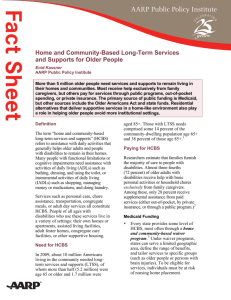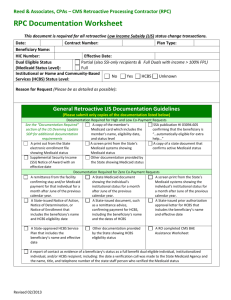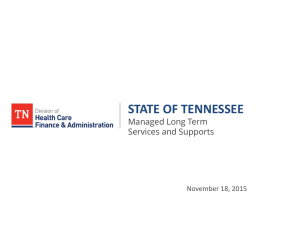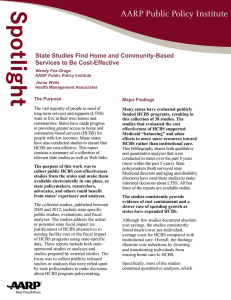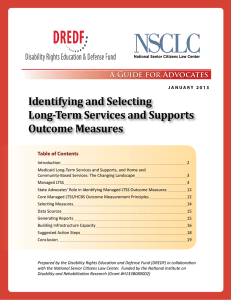In Brief AARP Public Policy Institute
advertisement
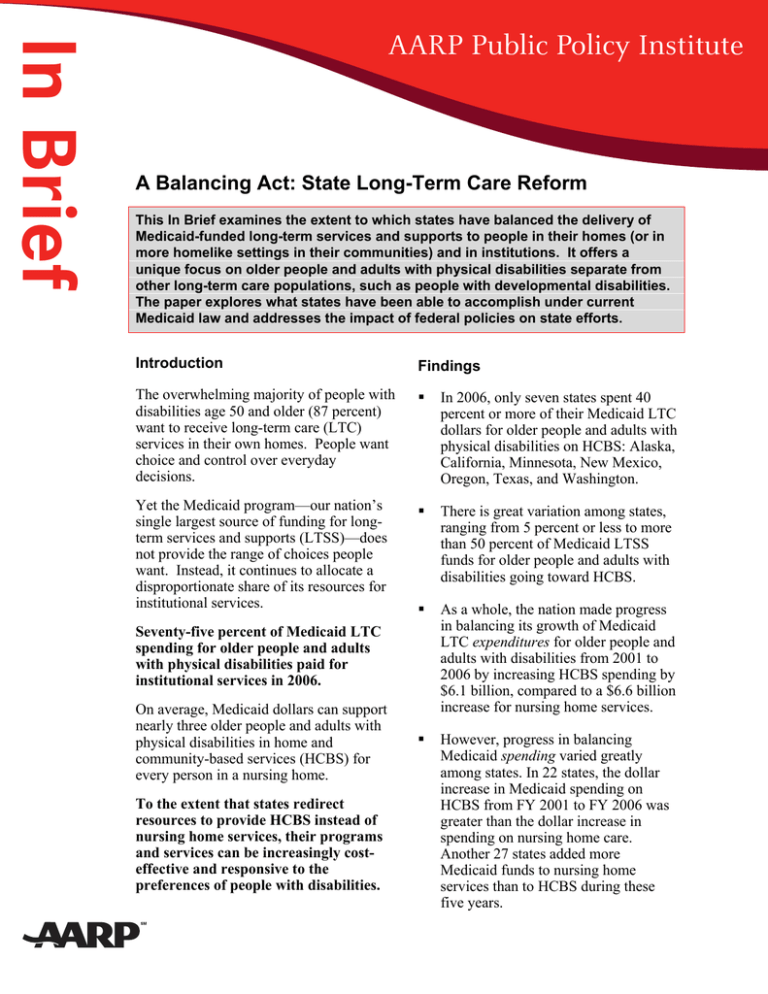
In Brief AARP Public Policy Institute A Balancing Act: State Long-Term Care Reform This In Brief examines the extent to which states have balanced the delivery of Medicaid-funded long-term services and supports to people in their homes (or in more homelike settings in their communities) and in institutions. It offers a unique focus on older people and adults with physical disabilities separate from other long-term care populations, such as people with developmental disabilities. The paper explores what states have been able to accomplish under current Medicaid law and addresses the impact of federal policies on state efforts. Introduction Findings The overwhelming majority of people with disabilities age 50 and older (87 percent) want to receive long-term care (LTC) services in their own homes. People want choice and control over everyday decisions. In 2006, only seven states spent 40 percent or more of their Medicaid LTC dollars for older people and adults with physical disabilities on HCBS: Alaska, California, Minnesota, New Mexico, Oregon, Texas, and Washington. Yet the Medicaid program—our nation’s single largest source of funding for longterm services and supports (LTSS)—does not provide the range of choices people want. Instead, it continues to allocate a disproportionate share of its resources for institutional services. There is great variation among states, ranging from 5 percent or less to more than 50 percent of Medicaid LTSS funds for older people and adults with disabilities going toward HCBS. As a whole, the nation made progress in balancing its growth of Medicaid LTC expenditures for older people and adults with disabilities from 2001 to 2006 by increasing HCBS spending by $6.1 billion, compared to a $6.6 billion increase for nursing home services. However, progress in balancing Medicaid spending varied greatly among states. In 22 states, the dollar increase in Medicaid spending on HCBS from FY 2001 to FY 2006 was greater than the dollar increase in spending on nursing home care. Another 27 states added more Medicaid funds to nursing home services than to HCBS during these five years. Seventy-five percent of Medicaid LTC spending for older people and adults with physical disabilities paid for institutional services in 2006. On average, Medicaid dollars can support nearly three older people and adults with physical disabilities in home and community-based services (HCBS) for every person in a nursing home. To the extent that states redirect resources to provide HCBS instead of nursing home services, their programs and services can be increasingly costeffective and responsive to the preferences of people with disabilities. A Balancing Act: State Long-Term Care Reform The nation made considerable progress by increasing the number of older people and adults with physical disabilities receiving HCBS, compared to the number served in nursing homes from 1999 to 2004. Offer a range of residential choices. Support family caregivers. Facilitate states’ ability to establish a unified global budget for funding LTC. The number of HCBS participants increased from 1999 to 2004 in 43 states and declined in seven. In 27 states, the number of nursing home participants increased over the same period, while the number declined in 24 states. Consolidate LTC programs, policies, and budgets in one state agency. Put a moratorium on Medicaid regulations that hinder states’ ability to help individuals leave nursing homes and transition to HCBS. Eliminate Medicaid’s institutional bias. Increase affordable public and private financing options to give people more choice and control over the services they need. Explore offering states financial incentives to accelerate the pace of change in shifting more Medicaid spending to HCBS. No Magic Formula Reforming a state’s Medicaid LTSS system is a complex process that requires commitment from state officials and cooperation from federal authorities. Positive transformational change of Medicaid’s LTSS system requires a philosophy that embraces the right of people with disabilities to live in the least restrictive environment; effective leadership; a creative problem-solving attitude that can find innovative ways to work within existing laws; and innovative ways to encourage federal policy makers to waive or overturn rules that hinder states’ ability to balance their service delivery in favor of HCBS. In Brief # 161, July, 2008 This In Brief is a synopsis of the AARP Public Policy Institute Research Report of the same title, number 2008-10 by: The ability of some states to accomplish substantial reforms demonstrates that obstacles to change can be overcome. Enid Kassner Susan Reinhard Wendy Fox-Grage Ari Houser Jean Accius AARP Public Policy Institute Change can be accelerated and supported by adopting federal and state policies that: Barbara Coleman Dann Milne Consultants Recommendations Allow consumers to receive services in the setting of their choice. Adopt nursing home diversion programs that prevent people from ever entering a nursing home. Eliminate waiting lists for HCBS. AARP Public Policy Institute, 601 E Street, NW, Washington, DC 20049 www.aarp.org/ppi. 202-434-3890, ppi@aarp.org © 2008, AARP. Reprinting with permission only. 2 In Brief

